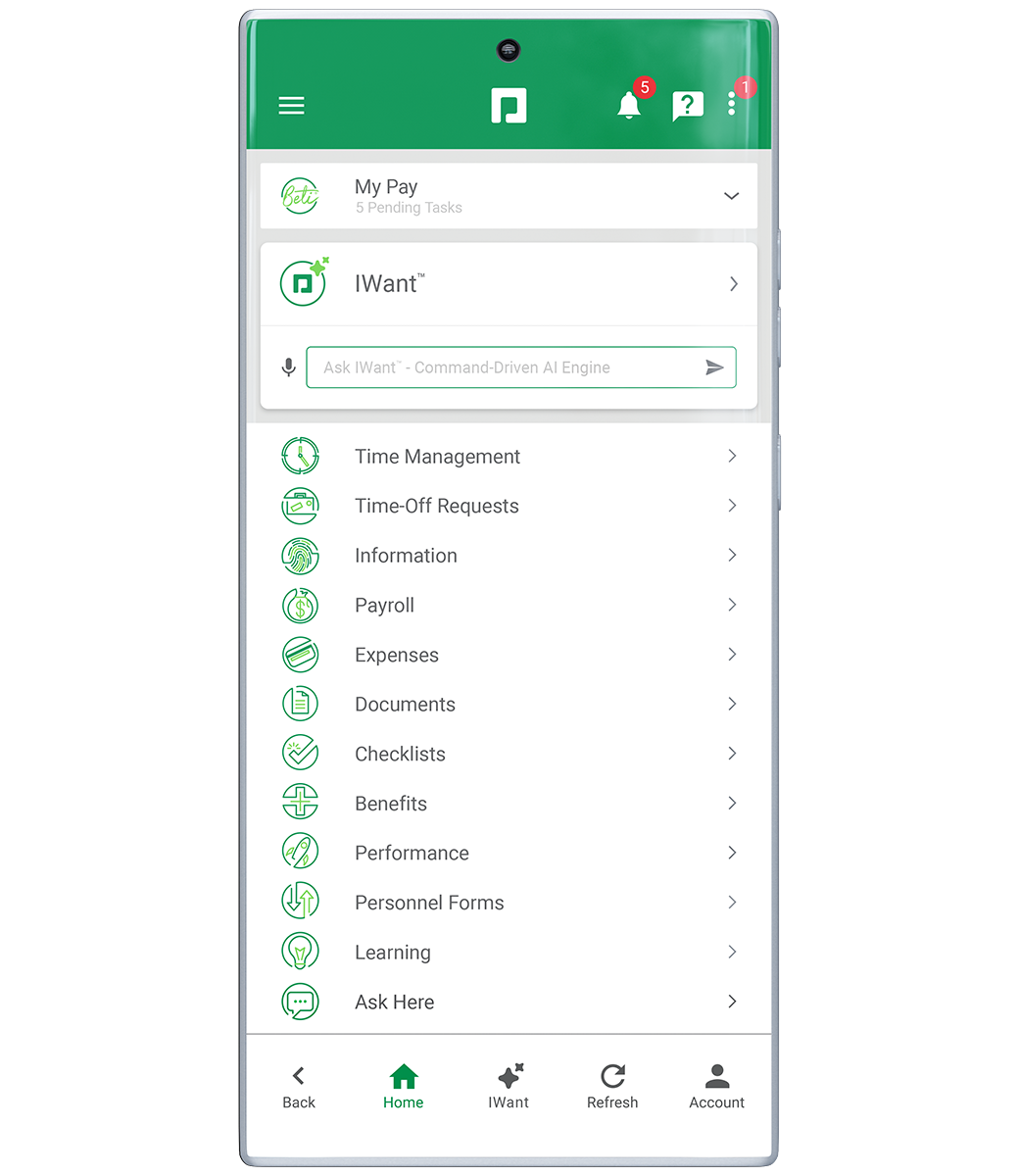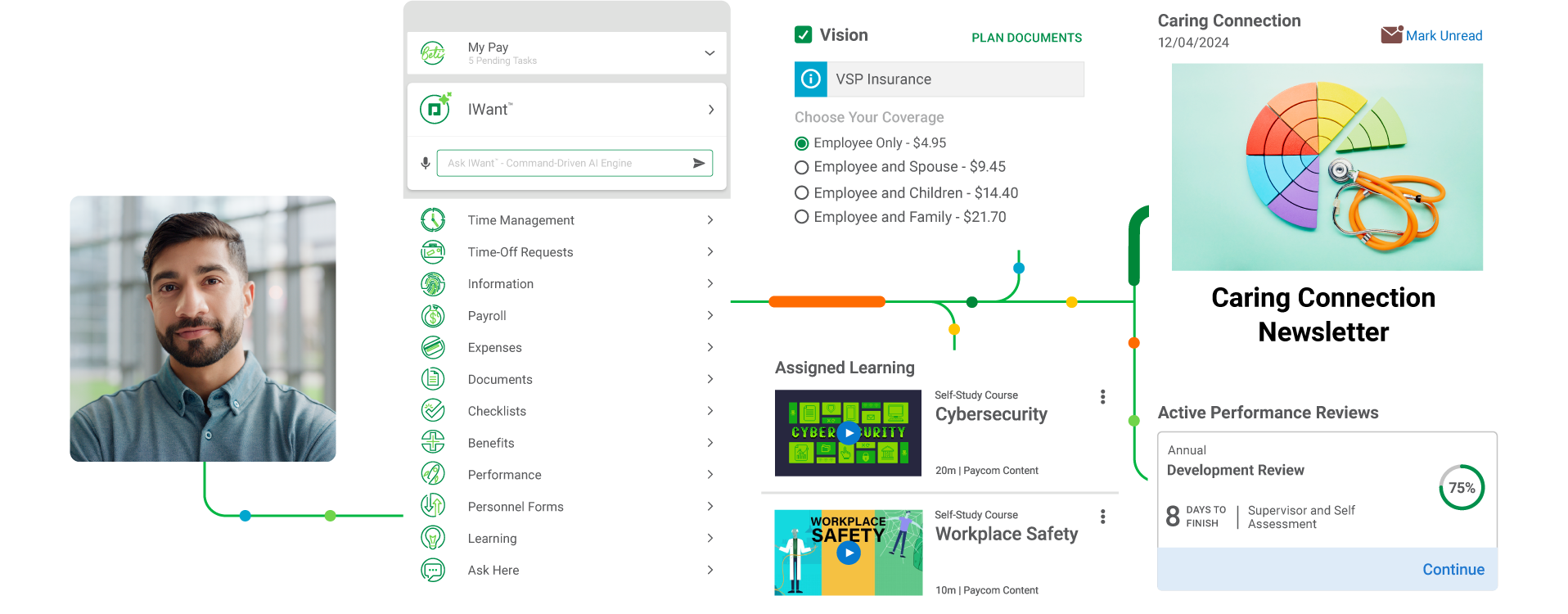Employee Self-Service®
Put the power of HR and payroll in your people’s hands with employee self-service software


What it does
Give your people the autonomy they expect

Today’s employees don’t just want easy access to their HR data — they demand it. And HR shouldn’t have to reenter the info your staff knows best. Put both issues to rest with our Employee Self-Service software. This intuitive experience lets employees review and manage their data 24/7 via desktop or our mobile app. Available in multiple languages and dialects, Employee Self-Service gives your people the power they deserve and HR pros the break they need from manual tasks.
Empower employees to:
- instantly and accurately access their own data
- onboard before Day 1
- set up direct deposit
- enroll in benefits
- access plan documents
- submit qualifying events
- update dependents and beneficiaries
- approve and troubleshoot payroll
- clock in and out
- request time off
- pick up or swap shifts
- upload and submit receipts
- track mileage automatically
- complete surveys, training and performance reviews
- ask work-related questions
- receive and read internal communications
- and more


Self-service solved
The best of automation and ease of use

With Employee Self-Service, your people enter their data once and only once. From there, data automatically flows to every relevant tool in our single software. No need for HR to waste time spinning plates and cross-referencing info. Admins get notifications about time off and other requests, while your people are alerted about approved or denied requests as soon as a decision is made.
We’ve fundamentally changed the way you use Employee Self-Service. Instead of searching for the data you need, simply ask IWant, our command-driven AI engine, and get instant, accurate answers pulled from our single database.

Beti®
Our automated payroll software builds itself by instantly applying changes your people make in Employee Self-Service. The tech even guides employees to fix their pay before payroll submission.

GONE®
A revolutionary enhancement to our Time-Off Requests tool, GONE automates time-off decision-making based on rules you set. This gives employees timely responses, eliminates inconsistency and helps you meet your scheduling needs.
What makes us different?
Everything employees need in one software
We don’t just promise a seamless self-service experience. We deliver it. With just one login and password, employees engage with your business through payroll, benefits, training, performance reviews and even internal communications. It’s all available on desktop or through the App Store and Google Play.


No more data reentry
Tired of your tech provider’s mergers, acquisitions and disjointed tools? Our software is built by Paycom, at Paycom. This approach allows the updates your people make in Employee Self-Service to flow exactly where they need to — without sticking HR in the middle.

Management made easy
Managers and HR are employees, too. With Paycom, supervisors can toggle between Employee Self-Service and Manager on-the-Go® without additional logins. From there, they can access the data they need instantly and accurately on command. And with MyCom, Paycom’s internal communication tool, you can create company announcements that show up right in your employees’ app.

Employees love Paycom
Over 1,000,000 5-star app ratings
CAPTERRA
APP STORE
GOOGLE PLAY

See what people are saying about Employee Self-Service
Solve your HR challenges
Boost trust, not liability

Employees don’t want their hands held. And HR doesn’t have time for it. So why subject them to a process that requires manual labor for both? By empowering your people with Employee Self-Service, you:
- raise trust, engagement and retention by connecting talent with instant, accurate access to their data
- increase accuracy and eliminate errors with employees’ changes flowing seamlessly across Paycom
- amplify your security with user access controls and two-factor authentication
- boost ROI with greater efficiency, fewer mistakes and flawless workforce management

Frequently asked questions
Learn more about employee self-service
Employee self-service software allows employees to enter and manage their HR and payroll information themselves, often through the use of a mobile app. Self-service tasks can include entering and updating contact information, direct deposit account details, beneficiaries and other personal data, as well as enrolling in benefits, entering time off and reviewing their paychecks before submission.
With self-service HR tech, employees manage every aspect of their paycheck, like PTO, expenses and benefits. Ours goes even further by putting payroll approval in the hands of those who know their paycheck best: your employees.
When you empower your employees with self-service HR and payroll software, you’re putting their information in the hands of who knows it best: them. Giving them a degree of autonomy in their tasks and decision-making processes as well as immediate, accurate retrieval of their data increases engagement and builds trust. Plus, meet your people where they are with newsletters and internal announcements delivered straight to their app for anytime, anywhere access.
No one knows employees’ data better than they do. When employees enter their own information through self-service software, accuracy increases and errors caused by data rekeying and reentry decrease. Plus, when employees have visibility into payroll before submission with self-service payroll, they’re able to help find and fix errors before they end up on their paychecks.
Because employees know their HR data best and want their information to be correct, empowering them to enter and manage their own data with self-service software cuts down on manual tasks and data reentry. These cost savings add up when, according to EY, the average estimated cost of a single HR data entry task is $4.86.
Yes! Paycom offers multiple ways for employees to get the most out of Employee Self-Service. With hands-on training during the implementation process, anytime access to courses about Paycom software and step-by-step guides on using the software, employees get tips and tricks in the way they learn best.
It empowers employees to take control of their HR information and processes by providing employees with the tools and information to manage their work lives effectively. By providing:
- convenience and accessibility. Employees can complete tasks anytime from anywhere with mobile access.
- transparency and trust. Employees can easily access pay stubs, benefits information and other important details anywhere at any time.
- efficiency and time-savings. Employees spend less time waiting on HR assistance on routine tasks, and automated notifications and workflows keep employees informed, reducing frustration.
- recognition and development. Employees access performance management tools that provide resources to track progress and goals and encourage feedback. And Paycom Learning offers access to training, upskilling and reskilling opportunities for further development and employee growth.
- improved work-life balance. Employees can swap shifts, review accruals and balances, request time off and quickly access benefit information.
The mobile app has all the functionality of the desktop version. However, if Mileage Tracker is added, the mobile app can also automatically track business miles for reimbursement.
Employees have access to their personal information, time-off requests, pay stubs, benefits enrollment and other self-service features.
Managers can toggle between Employee Self-Service and Manager on-the-Go, allowing for additional access to view and manage their employees, including approving time and time off, access to performance reviews and overseeing team schedules.
HR and payroll professionals can toggle between Employee Self-Service and Client Action Center, providing visibility into the status of active requests as well as direct contact with their dedicated Paycom specialist.


